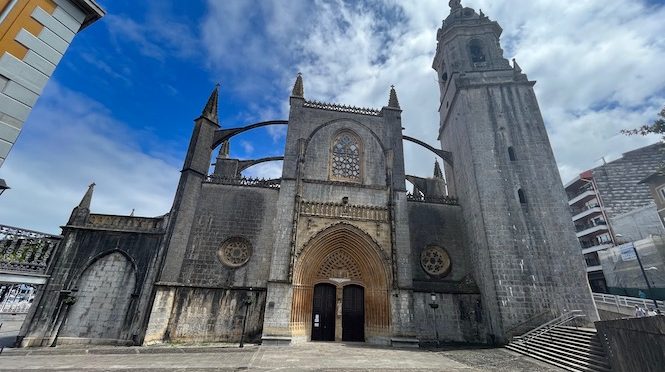Our next stop in our trek along the Basque Coast was Lekeitio, where we grabbed lunch. Since my first visit to the Basque Country in 1991-92, Lekeitio has always held a special spot. My mom’s grandmother, Ines Eiguren, came from that city. Her parents were the grounds-keepers for Mario Adán de Yarza, the man who brought pine trees to the Basque Country. During my first visit, I met her two, at the time very elderly, sisters who were still alive and had never married, instead taking care of their parents. I’ve visited several times since, particularly as my uncle Martin would often take me.
- Lekeitio sits at the estuary that forms when the Lea river, which flows down from Mount Oiz, meets the ocean. The town boasts the beautiful Isunza beach, but the Carraspio beach, belonging to Mendexa, sits right across the estuary and is also used by the people of Lekeitio. Perhaps the most distinguished landmark in the city is the Basilica of the Assumption of Our Lady. Built in the Basque gothic style in the 15th century, it displays flying buttresses and marvelous sculptures all around its exterior.
- The modern city is split between two centers, one that sits upon Mount Lumentxa and the other along the shore. Lekeitio was granted its fueros, or charter, in 1325 by D.ª María Díaz de Haro I, Lady of Vizcaya, daughter of Lope Díaz de Haro and wife of the Infante Juan de Castilla. In 1334, King Alfonso XI confirmed the charter and ordered the construction of walls around the city. Lekeitio is unique in the Basque Country in that it co-owns the assets of the local church, Santa Maria. It is also the first city in Bizkaia to establish city ordinances to govern the relations between the city’s inhabitants and to regulate fishing and other economic activities.
- Fishing was so important to the city that the Cofradía de Pescadores de San Pedro – the Fishermen’s Association of San Pedro – had the right to elect their own mayor that served alongside the mayor elected by the rest of the town. Whaling was another important economic activity, as reflected in the city’s coat of arms. Ship building and navigation were also big parts of the Lekeitio economy and at least three sailors from Lekeitio were on Columbus’s voyage to the Americas. For centuries, Lekeitio was the second most important port in Bizkaia, until it was overtaken by nearby Ondarroa.
- In fact, the rivalry between Ondarroa and Lekeitio goes back so far that its origins are lost in time. The lords of both towns participated in the War of the Bands, with rival families in each city. When the two cities were founded, there was ambiguity between their borders and that led to many disputes, such as whether Lekeitio could take wood from the nearby forest without taxation. The two towns also fought over which had the right for whaling in the nearby seas. The rivalry lasted for centuries and came to a head in 1926 when, after Ondarroa won a rowing competition, fights broke out between the two towns.
- By the 20th century, however, fishing declined as local stock was overfished. Tourism has grown in its place, with the population of Lekeitio swelling during the summer.
- Lekeitio’s history goes much further back. In the 1920s, several archeological sites were discovered that contained a child’s skull from post-Neolithic times (the Neolithic period was from 12,000 to 6,500 years ago) and flints. Axes and arrows were also found.
- One of Lekeitio’s most notable sons was the scholar and priest Resurrección de Jesús María de las Nieves Azkue.
- Lekeitio also stands out for the uniqueness of one of its fiestas. Those of San Antolín, the patron of the city, which are celebrated from September 1-8, include the Geese. Part of the local festivities for more than three centuries, this involves a goose suspended over the port by a rope. People have to hold on to the now-dead goose, greased in fat, as the rope is pulled and loosened so that the person is continuously dipped into the water, until either the person lets go or the goose’s neck breaks. While the origin of the strange event is lost, it possibly comes from ancient times.
Primary sources: Lequeitio, Wikipedia; Arozamena Ayala, Ainhoa. Lekeitio. Auñamendi Encyclopedia. Available at: https://aunamendi.eusko-ikaskuntza.eus/en/lekeitio/ar-79286/
Discover more from Buber's Basque Page
Subscribe to get the latest posts sent to your email.




We stayed in Lekietio for a few nights in one of the 5-story rentals, but we loved the centro area much better. There was a Basque-shop there. but it was closed when we were there. The church really touched me, and now I know why because your great grandmother Ines was probably there with me in spirit.
I also met Juan Insunsa at the University of New Mexico during my Spanish language program in the 80’s. He was there for a short while and encouraged me to travel to the Basque Country so many years ago…I finally made it!
Very cool, Lorin! Glad you had such a great visit. I’ve never stayed in the town and have only visited for an afternoon here and there. Maybe I’ll have to spend a little more time there in the future.
Hello,
I visited Lekeitio and stayed at the Villa Itsaso in June 2018. Trying to find out more about the area where the Aranzibia lived. (over 500 years ago). There is the Torre Aranzibia by Gardotza (off route BI-633) now just an apartment building, it seems.
In Lekeitio, I found a street named Aranzibia to my delight.
Any insight to the name would be greatly appreciated.
Lekeitio was a pleasant town. Will do it again.
Cheers,
Victor Ariel Arencibia Varona, N.J., U.S.A.
Kaixo Victor! I don’t have any information about Aranzibia but hopefully someone else might.